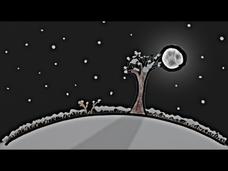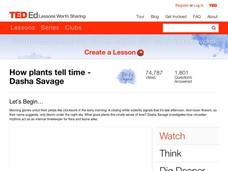Crash Course Kids
Seasons and the Sun
Discover the differences between summer and winter, besides coats and bathing suits, with a short and informative earth science video. Sabrina, the narrator of the animated video, talks about the ways the earth's tilt affects the seasons...
TED-Ed
Why Do Some People Have Seasonal Allergies?
Not everyone looks forward to the spring, because it means allergy season for some. An informative video takes a deeper look into what happens to the immune system when seasonal allergens attack.
PBS
Seasonal Science: Raptor Migration
45 percent of all raptors migrate, but they don't follow the paths of other migrating birds. An extensive Seasonal Science series introduces the unique migration process of raptors. The narrator explains the extremely small migration...
MinutePhysics
Why The Full Moon is Better in Winter
Did you ever wonder which season is best for viewing the full moon? Find out why winter wins the honor, and why the tilt of Earth''s axis is the main contributor.
TED-Ed
Why Should You Listen to Vivaldi's "Four Seasons"?
While many of your class members may find the opening strands of "The Four Seasons" by Antonio Vivaldi familiar, few may know of the rich history of this program music. Viewers not only listen to portions of the music from each season,...
PBS
Seasonal Science: Frostbite
Fingers, toes, and nose. Oh, my! It's so cold outside. An animated video models the four-step progression of frostbite and how it affects the human body.
TED-Ed
How Plants Tell Time
Can someone really have a "biological clock"? Discover why many organisms on earth have an inherent awareness of where they are in the day's cycle.This video discusses animal adaptations, the earth's revolutions, and how light and...
Howard Hughes Medical Institute
Gorongosa's Water Cycle
Gorongosa National Park holds a fascinating and ever-changing landscape. What makes the water cycle in the park so special? Travel to Mozambique to learn more about the park using a short video. Content includes rainy season in the park,...
Be Smart
When Is It Winter On Other Planets?
Bundle up for a trip through the climates of the solar system. An informative video explains the seasons of each planet. The presenter demonstrates how the location and tilt of each planet determine the climate patterns.
Crash Course Kids
Earth's Rotation and Revolution
Where does the sun go at night? Don't worry, it's just facing the other side of the earth. Learn about Earth's axis, tilt, rotation, revolution, and what all this means for your summer vacation with an engaging earth science video.
Bozeman Science
LS2D - Social Interactions and Group Behavior
Humans aren't the only ones with social networking skills! Examine a fascinating video resource focused on standard LS2D of the Next Generation Science Standards. The narrator guides you through the organization within groups, the...
Scholastic
Study Jams! A Day on Earth
It's good thing that it isn't up to RJ to spin the earth on its axis; he can't even keep a basketball spinning! In this video animation, he and viewers learn about Earth's movements in space. One thing to consider before you use this...
Howard Hughes Medical Institute
Measuring Circadian Activity in Drosophila
How many hours should be in a day? One species of drosophila naturally prefers a 24.5 hour day, while another strongly prefers a 19-hour day. An animation and graph share data from each of these species when exposed to the typical light...
TED-Ed
"The Road Not Taken" by Robert Frost
What happens when people take the road less traveled? Scholars explore the topic using the first episode from season one of the There's a Poem for That playlist. Viewers watch an animated adaptation of Robert Frost's classic and...
TED-Ed
"To Make Use of Water" by Safia Elhillo
How can someone manipulate language to describe an essential resource such as water? Pupils consider the question with the second episode from season one of the There's a Poem for That playlist. Learners watch an animated version of the...
CBC (Canada)
Your Odds of Becoming an Olympian
Which country and sport would give you the best odds of participating in the Winter Games as an Olympian? Including some fun facts on the demographic make-up and Olympic ties of various countries around the world, this is a brief and...
Be Smart
The Deadliest Flu Season in History?
Is it possible for another flu outbreak like the Spanish Flu in 1918? A video lesson explains the factors that affect the spread of a virus and its effect on a population. The narrator describes the structure of the different virus...
TED-Ed
"The Nutritionist" by Andrea Gibson
How can poems help people express their innermost feelings? With episode three from the first season of the There's a Poem for That playlist, pupils listen to the narrator share about her inner world. As Andrea Gibson reads her poem,...
TED-Ed
What Happens When You Get Heat Stroke? sun stroke, homeostasis, body temperature
Exertional heat stroke is one of the three leading causes of death in sports, but with the help of this video young athletes will be able to avoid this life-threatening condition. Offering clear explanations of how the body dissipates...
MinuteEarth
Birds that Hibernate in Lakes?!
Birds seem to disappear at various times of the year, and many early theories about this phenomenon turned out to be wrong. The video introduces two of these theories as well as how scientists learned the truth. It explains a few...
Curated OER
Spring Symphony In The Meadow
Using animation and music, the spring season in a meadow is explored. There are animated creatures, a downpour of rain and more.
TED-Ed
What Cameras See That Our Eyes Don't
Cameras are amazing tools that enhance the way we see the world. From capturing time-lapse footage of seeds sprouting or seasons changing, to high-speed photography showing a bullet crashing through its target, cameras allow us to see...
TED-Ed
Why Do We Kiss Under Mistletoe?
Hanging mistletoe is a holiday tradition, but where did the idea of kissing under mistletoe come from? In actuality mistletoe can be found in nature throughout all four seasons, and is home and food to birds and insects. Watch a video...
TED-Ed
"Three Months After" by Cristin O'Keefe Aptowicz
What does despair feel like, and what does it look like? Pupils explore the theme of sadness with the sixth episode from the first season of the "There's a Poem for That" playlist. They watch an animated representation of Cristin O'Keefe...

























